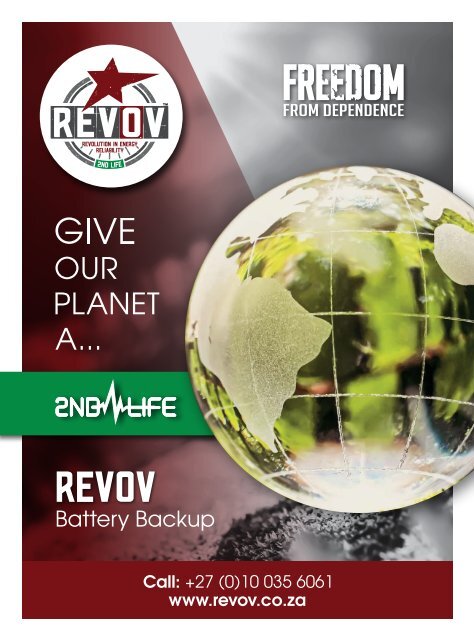Green Economy Journal Issue 57
You also want an ePaper? Increase the reach of your titles
YUMPU automatically turns print PDFs into web optimized ePapers that Google loves.
ENERGY<br />
We are morally obliged to demand<br />
ENVIRONMENTALLY SOUND<br />
BATTERIES to store RENEWABLE ENERGY<br />
The energy crisis in South Africa has fundamentally changed how most people see electricity,<br />
and it took a leap in the right direction when Finance Minister Enoch Godongwana announced<br />
incentives for South Africans to invest in solar energy.<br />
BY REVOV*<br />
There’s always a tinge of irony that what should be an<br />
environmentally conscious decision is forced by the inability<br />
of the national power utility to produce enough electricity<br />
and volatile fuel prices which make running internal combustion<br />
generators exceedingly expensive – especially during prolonged<br />
periods of loadshedding at higher stages.<br />
Be that as it may, some would argue that it doesn’t matter how<br />
one arrives at the correct destination, what matters is that they have<br />
arrived. So, let’s talk solar. Very simply, as everyone reading this will<br />
understand, solar panels convert sunlight into power that can be<br />
used in homes and businesses.<br />
However, anyone who watches the Eskom updates daily on power<br />
usage will see that renewable energy is not fixed. There are periods<br />
where more is produced, and periods where less is produced. This is<br />
the nature of the environment. Either there is good sunlight or it is<br />
overcast, either there is plenty of wind or there is not.<br />
It’s here where many who have not yet seen the light – pun intended<br />
– miss the point, and also why there comes a time in every national<br />
dialogue that batteries and large battery installations come into the<br />
spotlight. This is because batteries, configured correctly in a renewable<br />
energy installation, can store the power being produced to provide a<br />
constant, reliable and predictable flow of electricity.<br />
Understanding this is the first step of an environmentally responsible<br />
citizen. The second step is in appreciating that the battery you use<br />
affects whether you are making the most of the clean power being<br />
produced. Ask yourself: are you even aware of the carbon footprint of<br />
the batteries stacked in your garage or warehouse.<br />
Lithium iron phosphate batteries have proven, time and again, to be<br />
the best chemistry for battery storage. Lithium iron phosphate is safe,<br />
reliable, effective and enjoys a much longer lifespan than other battery<br />
types such as gel or lead acid. However, not all lithium iron phosphate<br />
batteries are the same.<br />
Some, which are called LiFePO4, are made – at the outset – for storage<br />
solutions. Minerals are mined, beneficiated and configured into batteries<br />
for the storage market. This market competes with the electric vehicle<br />
(EV) market, where increasing demand results in increasing prices.<br />
Even worse, a new class is emerging. Class B storage cells, which<br />
manufacturers and white labelers are now calling “cost effective”, with a<br />
reduced warranty and cycle life. Watch out.<br />
The batteries made for the EV market are engineered differently,<br />
to withstand harsh operating conditions such as higher temperatures<br />
and charge and discharge rates. Every EV needs to change its battery<br />
when the weight is no longer justified by the output. However, within<br />
these batteries that are removed are some perfectly sound individual<br />
battery cells.<br />
Instead of throwing the whole battery into a landfill somewhere and<br />
poisoning the planet, environmentally conscious engineers take these<br />
good battery cells and configure them into storage batteries, which<br />
we call 2nd LiFe. These batteries have comparable lifespans to LiFePO4<br />
batteries, with the added benefit of being able to withstand harsh<br />
operating conditions.<br />
Understanding this is crucial: the batteries are not secondhand –<br />
they didn’t exist until now. Rather, their individual cells are made up<br />
of the good cells that were retrieved from EV batteries and repurposed<br />
into storage battery units.<br />
It’s here where the homeowner and business owner can drive<br />
positive change and a crucial environmentally conscious mindset<br />
in South Africa’s revolution towards renewable energy: even if it<br />
has been forced on them. The carbon cost of 2nd LiFe batteries has<br />
already been paid. These batteries are as near to carbon neutral as<br />
one can find, whereas the LiFePO4 batteries come at a significant<br />
carbon cost that includes mining, shipping, beneficiation and<br />
complex logistics all the way to installations near you.<br />
Either there is good sunlight or<br />
it is overcast, either there is<br />
plenty of wind or there is not.<br />
The 2nd LiFe battery cells paid their carbon dues in their first life<br />
in EVs. Make no mistake, LiFePO4 batteries are still far better and<br />
cleaner options than the archaic chemistry called lead acid. If you’re<br />
undecided, always choose lithium over lead.<br />
Customers can drive a mindset shift. It’s about time more people<br />
look around and appreciate the immense damage we have caused to<br />
the environment. Extreme weather events and entire ecosystems are<br />
at risk. This means it is not only admirable but non-negotiable that we<br />
put the planet front and centre in all investment decisions – especially<br />
those that harness clean energy.<br />
*Written by Lance Dickerson, MD, REVOV.<br />
37

















